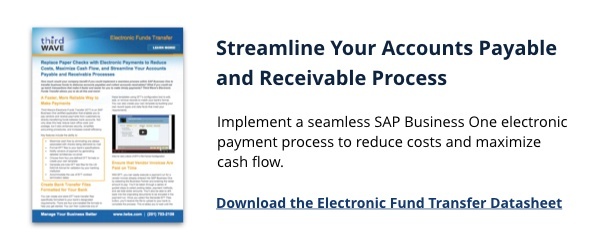Question: Who would be a target client for Third Wave Business Systems?
Answer: Someone who is looking for any/all of the following:
-a reliable partner who will provide extended support
-a business management software with reasonable pricing
-working with a customer focused team
-a single, integrated software solution
-cost effective ways to manage their business activities
-upgrading from QuickBooks or other similar software
-small to midsized business wanting to grow
-work in the areas of Distribution, Manufacturing, or Professional Services
-automated business processes
-want to experience maximum Return on Investment (ROI)
-maxiumum CRM functionality
-reporting capabilities
Third Wave Business Systems specializes in setting up SAP Business One and Microsoft Dynamics GP solutions for customers who are looking for any of the above wants/needs. By thinking outside-the-box, we are able to provide software that fits you processes, instead of making you change the processes you have in place to fit the software we’re implementing.

Who is Your Target Client?
Learn More
Stockouts in your company can be directly correlated with one word: loss. The hidden costs of stockouts are ultimately the profit you should be making during the time an order is placed, but can’t be filled right away due to lack of inventory. Stockouts are expensive and difficult to manage. You may think that the only way to prevent a stockout is to have an excess of material in stock. There are easier ways of making sure you are carrying the right amount without carrying too much. In order to be competitive in the market, companies need to be able to determine appropriate stock amounts.
When your company experiences stockouts, it is synonymous with bad/lack of inventory allocation methods. Without a process to monitor and predict inventory, you will experience incorrect inventory amounts at the wrong times. These irregularities are a contributing factor to stockouts. Because these important, time-sensitive processes aren’t in place, there will always be an increase in inventory planning time. You aren’t able to think ahead because you are too distracted with your present situation. You will see an increase in back orders because of your raising demand from customers. Simply put, you can’t keep up. While spending too much time worrying about factors that should be able automated, you are ultimately contributing to a decrease in total revenue.
The bottom line when it comes to stockouts is loss:
- Loss in time – With a high customer demand and a poor planning strategy, you will constantly be losing time planning orders. Planning procedures that aren’t optimized take up valuable time. You will constantly be searching for better information, without actually being able to find it.
- Loss in customers – Your customers will be fed up with waiting around and will get their orders fulfilled from a different vendor.
- Loss in productivity – You are wasting time working on processes that could otherwise be done automatically.
- Loss in inventory – Without proper planning, you will end up purchasing the wrong things for the wrong times, ending up with useless excess inventory.
- Loss of market competitiveness – Without requested product quantities and no turnaround, you will not be able to keep up with your competition.
- Loss in information – With no means of seeing into your future, it is nearly impossible to obtain the right information at the right time.
- Loss in revenue – Stockouts will result in lost sales and higher expedited shipping costs. Your ends will always outweigh your means.
Perhaps a different way to view the question “What are the hidden costs of stockouts?” could also be “How much is lost when you lose a customer? And how much will it cost to replace that customer?” Let’s face it; if you don’t have in stock what your customer wants, they will go to a different vendor for it. If that vendor is able to easily and quickly fill their order, chances are they will stick with that vendor.
By looking at certain factors that might help eliminate stockouts, you can bring yourself one step ahead of the game. Factors that play into being able to forecast the end result of a stockout could be: Do you sell commodity or specialty items? Are your customers business related or consumers? Who are your repeat customers and one-time purchase customers? What is your customer acquisition cost?
The experts at Third Wave Business Systems can help reduce stockouts by providing a seamlessly integrated advanced inventory planning solution for SAP Business One. You will find that implementing and working with a solution that automatically reduces inventory and eliminates stockouts will ultimately increase productivity, improve customer satisfaction levels, increase sales, and turn all of those “losses” into “wins”.

“What Are the Hidden Costs of Stockouts?”
Learn More
Question: What if SAP is too powerful for my company? Is there a starter version?
Answer: Yes! Third Wave recently introduced Starter Pack for the SAP Business One Starter Package for small to mid-sized businesses. Available through SAP channel partners, the starter package is preconfigured for up to five software users and has the same basic capability as the full SAP Business One application. This software is perfect for companies who need more than standard accounting software, but don’t need the power of the full SAP Business One. Starter Package’s functionality enables you to manage:
- Accounting & Financials
- Sales & Customers
- Purchasing & Operations
- Inventory & Distribution
- Reporting & Administration
The most beneficial aspect of Starter Package is that as you grow over time, you can upgrade to the full version of SAP Business One without investing in completely new software. You can simply import your new licenses and will be ready to go with the extended functionality.

Starter Pack FAQ
Learn More
What Is Marketing Campaign Management (MCM)?
Marketing and Campaign Management is a solution that extends the power of SAP Business One by enhancing Customer Relationship Management (CRM) capabilities and allows users to manage Marketing activities such as email, call, or print campaigns while tracking results. It allows users to perform complete Lead Management functions from initial contact all the way through to invoicing and beyond.
Managing leads, assigning activities, notes and more, are really simple and easy to use with MCM. Campaigns also benefit from the power of MCM. They are much easier to manage and execute. The ability to create multiple phases to a campaign, make them active, and draft them makes your marketing activities more organized and easier to work with.
MCM navigates just like SAP Business One, reducing the learning curves to a minimum. MCM also is a tool that will provide you with a 360 degree view of not only your customer relationship management activities but also your marketing activities. It allows everyone in the organization, whether they are in sales, service, or other departments, to understand and leverage the importance of marketing and CRM in today’s competitive world.
Who Uses Marketing Campaign Management?
Companies who are interested in the following:
- A single view of the organization from a marketing perspective, most especially to manage CRM functions and marketing functions all in one place.
- To get the edge in today’s competitive marketplace, companies must “respond faster to inquiries” to stay ahead of the competition.
- Are looking to actually target their marketing audience. With MCM, you have the capability to create specific campaigns and programs that are easy to set up.
- Information is the key to success. The more information you are able to capture and retain from a prospect, the easier it will be to market them in the future.
Cool Features of Marketing Campaign Management
- The ability to manage large prospect lists and campaigns from one easy interface, thereby eliminating multiple sources such as Excel documents, access databases, etc. to manage your previous activities
- Allows users to track the results of completed marketing activities.
- When a date gets entered into MCM, it is available real-time to others as well, making information available when and where you need it.
- As your marketing efforts continue over time, MCM enables you to determine what your prospects and clients react to for you to effectively market to their needs.
- Since managing leads is so critical today, having the ability within the one interface makes it easy to track leads, assign activities to others, and follow up when needed.

The Power of MCM (Marketing Campaign Management)
Learn More
EFT, or Electronic Funds Transfer is a process where companies typically will pay their accounts payable invoices via an online banking format, also known as NACHA. It is done through SAP Business One with a 5 step wizard. You select the vendors and the invoices that you want to pay and EFT creates all of the payment information and subsequently an electronic file that the user uploads on a secure FTP site at the bank location. It eliminates the need to write checks, print checks, put checks into an envelope, mail checks, and then wait for them to clear.
It can also be used on the Accounts Receivable side as well, assuming your customer has an ACH (American Clearing House) tool. But primarily it is used on your Accounts Payable side, when you’re trying to pay people or organizations for invoices.
So in a normal, check-printing environment, what you would do is to go out and select the invoices you want to pay, print a report and put it on your supervisor’s desk for them to check which to pay and which to not pay. After that, go off and select which ones you want to print, print them, line them up, put them back on the supervisor’s desk for a signature, get them signed, stuff in an envelope, and mail it with a copy of the invoice.
Needless to say, a long process. ACH eliminates that whole process, making the approval process electronic, meaning internal from SAP and eliminating the need to print checks and reports. Once the invoices are approved to be paid off, you simply follow the wizard in EFT which then creates a bank file. You go to the FTP site for the bank and upload the remittance copy. You can also send off a remittance copy to the vendor stating what invoice you’re paying, what the amount is, and telling them to expect it deposited in their account within 48 hours.
The real pain EFT resolves is the whole process of getting the manual approval to get an invoice paid, printing checks, having them signed, stuffing envelopes, putting on postage, and mailing them with a copy of the invoice attached.
Real Life Example
Canada had a Postal Service Strike this past spring and summer. It was a nightmare for them because instead of spending $.75 to mail something, they were paying a courier which is about ten times more expensive than it is to send an envelope to your vendor to pay an invoice. Using EFT would eliminate this situation, and going paperless would avoid any future problems.

EFT (Electronic Funds Transfer)
Learn More
Question: What, in your opinion, is the coolest thing you can do with SAP Business One?
Answer: One of the cooler new features in Business one 8.8.1 is the ability to set up scheduled queries to be run at certain times and deliver ad hoc reports to users. It can be scheduled to send it to users on regular bases. Customers need to monitor certain activities and list of to-do’s and this can help keep that information front and center for our customers
Here is a screen shot of the query manager’s scheduling capability. As you can see, very useful and easy to use.

-Mark Breznak, COO

Cool Feature FAQ
Learn More
IPortal is a tool that companies can use to publish information from a variety of data sources, not limited to SAP Business One. They can publish data from any sequel server database on the web to be consumed by a wide variety of audiences, internal or external to the company. Internal examples are salespeople, employees who want to log in and check various pieces of information, which could even be something like how many vacation days they have left. Salespeople can login and check who their customers are and who are the contacts of the customers, what their phone numbers are, how many orders they have placed, commissions for the month, and much more. Some external examples are customers and vendors. Customers can login and check their open invoices, check the status of their orders, or tracking numbers linked to the UPS site. Vendors can check what kinds of orders have been placed with them in the past few months, what the inventory levels are, etc. The most important function to remember is that you can easily publish data from a variety of sources and have it be accessed by internal OR external audiences.
The publishing part is the easy part. It is easy to publish data on the web, but to do it in a secure fashion and a manner that enforces data ownership is very important and that’s what we do. Security obviously ensures that the person logging in has access to the view that is being published.
Data ownership is a little more complex. Say you’re logging into IPortal to check your PTO. There might be a view published there that has all the employees at your company, but when you log in you shouldn’t be seeing all the information, only what pertains to you. That is data ownership, meaning in a view with a hundred or more records and all the employees’ information, IPortal is uniquely able to identify you as the person logging in and therefore show only your information. The same thing applies for salespeople. When they log in, they should be able to see only the customers that they’re working with, not what other salespeople are working with. And when viewing commissions, this becomes crucial that they see only their information, not others’ information. The same theme carries on for customers. As soon as they login they should only be seeing their orders and invoices. IPortal does that in a very easy fashion, and it’s very flexible.
In addition to the user being able to view information, they can also export information so they can do further analysis (xml, csv, and xls options).
The product is completely web services based, which means it’s highly scalable. The more users you have, you can add on infrastructure to scale up. IDS is very flexible in terms of scaling up or down based on the needs of the customer. And it’s also extensible. One of the advantages of web services is if customers need to modify anything, they can be provided with hooks to be able to do so (i.e. if they want to customize the look and feel or they want to programmatically integrate with IPortal in some fashion, they have the ability to do that). The whole infrastructure is browser based, so it is very beneficial because you don’t have to download or install anything. If you have one of the modern browsers, you’re able to access information. This information, in addition to being viewed on a web page on a computer, is accessible to be viewed on mobile or tablet devices. This is especially beneficial for remote employees, like salespeople who are on the road all the time.
In addition to viewing data, they can also see charts. Say you want to take a look at your business partners, a list of customers from SAP. Once you click on that, it lists all the information. You can drag items you want to compare against others by dragging and dropping into a top bar. Users and administrators can create specific filters to what they need. By viewing this information through charts, it takes visualization to a whole different level.
Practical application – when we get a new SAP B1 customer. They are most likely migrating from another software solution that they were using. They might be concerned about all the invoices, customer balances, customer lists, or any other kind of information that they will want to bring into SAP from their previous system. Instead of brining everything in, they could set up IPortal and any time they want to reference information, they can just go into IPortal and see that information.

IPortal
Learn More
Question: In your opinion, what is TWBS’ most valuable SAP add-on product?
Answer: In my experience, the Advanced Productivity Pack (“APP”) provides consultants and power users a toolkit in which they can creatively quickly develop automated procedures that can be used every day by end users.
One example, we’ve used APP to automatically send customers dunning letters (once per week for more than 60 days and once a month for more than 30 days) while also including a copy of each unpaid invoice. The work in building this process was very fast – we simply built a SAP Business One query to list each customer that had at least one invoice open more than 60 days or 30 days. We then took the standard statement Crystal Report that is included with APP and altered it to look like a dunning letter. We then copied existing AR invoice Crystal Report to show all open invoices. Prior to implementing this, the collector manually reviewed an aging report and manually printed a dunning letter for each customer based on their open AR. They then had to address and mail all of the dunning letters to the customers. After we implemented this functionality, the process to email dunning letters and open invoices became a two minute per week, three-click process. Due to the added benefit of including copies of all open invoices, it reduced the number of customer collection and follow-up calls by approximately 70%.
Another example during an implementation was that we built a process that is three clicks at the end of day, APP automatically emailed delivery confirmation, a copy of the packing slip with tracking numbers to every customer for every shipment for that day. Prior to having APP, this was not even possible. The customer service could only answer emails and phone call inquires asking for shipping status and tracking numbers.
Virtually every opportunity to improve business partner relationships, such as communication, automation, and correspondence can be accomplished with APP.
-Michael Neuendorff, Consultant

Add-on FAQ
Learn More
